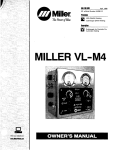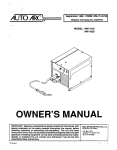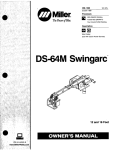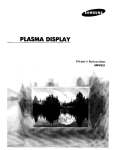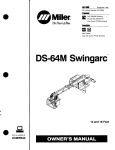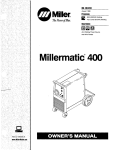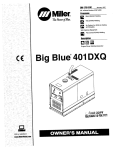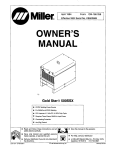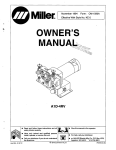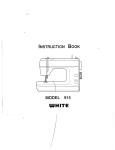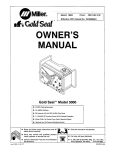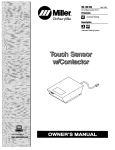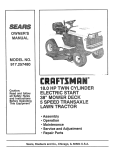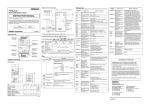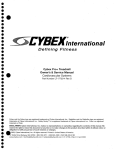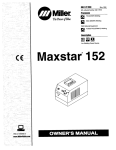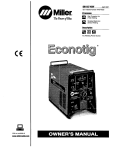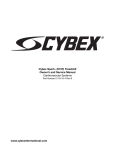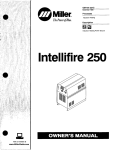Download Miller Electric AUTO ARC MWG 160B Specifications
Transcript
OM-187 925A August AUTO ARC L Ifi 1998 Processes ~ MIG(GMAW) Flux Cored (FCAW) Description Wire Feeder Auto Arc 120 For Technical Milweld P.O. Box Support, Contact: Inc., National Distributor 338, Hortonville, WI 54944-0338 Tel 920-779-0924 Fax 920-779-0924 OWNERS MANUAL 0 SECTION 1 PRECAUTIONS- - EFQRE USING READ som_nd_5/97 Symbol Usage 1-1. Means Warning! Watch Out! There are possible hazards with this procedure! The possible hazards are shown in the adjoining symbols. a A ~ ~: ~.~T~:. Marks This group of symbols means Warning! Watch Out! possible ELECTRIC SHOCK, MOVING PARTS, and HOT PARTS hazards. Consult symbols and related instructions below for necessary actions to avoid the hazards. special safety message. a ~tT Means Note; not safety related. ~ A The symbols shown below are used throughout this manual to call attention to and Identify possible hazards. When you seethe symbol, watch out, and followthe related instructions to avoid the hazard. The safety information given below is more complete safety information summary of the found in the Safety Standards listed In Section 1-4. Read and follow all Safety Standards. only a A Only qualified persons should instail, operate, maintain, and repair this unit. A During operation, keep everybody, especially children, away. If earth with a grounding workpiece is do not work use required, ground it directly clamp or work, cable. Do not touch electrode if you are in contact with the work, another electrode from a different machine. Use only well-maintained parts ground, equipment. Repair or replace damaged according to manual. at once. Maintain unit a safety harness if working above floor level. Keep all panels and,covers securely in place. Wear Clamp work cable with good worktable as near Insulate work metal-to-metal contact to the weld as workpiece practical. clamp when not connected object. to workpiece to prevent contact with any metal Do not connect electrical parts can cause fatal shocks or severe burns. The electrode and work circuit is electrically live whenever the output is on. The input power circuit and machine internal circuits are also live when power is on. In semiautomatic or automatic wire welding, the wire, wire reel, drive roll housing, and all metal parts touching the welding wire are electrically live. Incorrectly installed or improperly grounded equipment is a hazard. live Touching - or or ill of the cable separate single weld more than one electrode or work cable to any output terminal. SIGNIFICANT DC VOLTAGE exists after removal of input power on inverters. Turn Oft inverter, disconnect input power, and discharge input capacitors according to instructions in Maintenance Section before touching any parts. Do not touch live electrical parts. dry, hole-free insulating gloves and body protection. Wear Insulate yourself from work and ground using dry insulating mats big enough to prevent any physical contact with the ground. ANP.~,S~S~an bardous. or covers work or Do not useAC output in of there is a Use AC output ONLY If AC danger output is damp areas, if movement is confined, or if if required, required for use the remote welding output control if present on input power or stop engine before installing or equipment. Lockout/tagout input power according OSHA 29 CFR 191 0.147 (see Safety Standards). Properly Owners this install and Manual and ground this equipment according to its national, state, and local codes. Always verify the supply ground check and be sure that input power cord ground wire is properly connected to ground terminal in disconnect box or that cord plug is connected to a properly grounded receptacle outlet. - When making input connections, conductor first - attach proper grounding double-check connections. Frequently inspect input power cord for damage or bare wiring replace cord immediately if damaged bare wiring can kill. - - Turn off all Do not Do not use equipment worn, drape when not in over your body. or poorly spliced out of the fumes. Do not breathe the fumes. If inside, ventilate the area and/or remove welding fumes and gases. If ventilation is poor, use an Read the Safety cables. Material manufacturers use exhaust at the arc to approved air-supplied respirator. Data Sheets (MSDS5) instructions for metals, consumables, and the coatings, cleaners, and degreasers. confined space Work in a wearing an only if it is well ventilated, or while air-supplied respirator. Always have a trained watchperson nearby. Welding fumes and gases can displace air and lower the oxygen level causing injury or death. Be sure the breathing air is safe. Do not weld in locations operations. form highly near degreasing, cleaning, The heat and rays of the arc toxic and irritating gases. can or spraying react with vapors to coated metals, such as galvanized, lead, or unless the coating is removed from the weld area, the area is well ventilated, and if necessary, while wearing an air-supplied respirator. The coatings and any metals containing these elements can give off toxic fumes if welded. Do not weld cadmium use. damaged, undersized, cables =~i Keep your head process. Disconnect to fumes and gases. Breathing these fumes and gases can be hazardous to your health. falling~ unit. servicing Welding produces on plated steel, OM-187 925 Page 1 canbu Arc rays from the welding process produce intense visible and invisible (ultraviolet and infrared) rays that can burn eyes and skin. Sparks fly off from the weld. f__ S Shut off S Always ventilate confined spaces approved air-supplied respirator. shielding gas supply when not in use. or use Wearawelding helmetfitted with a propershade of filterto protect your face and eyes when welding or watching (see ANSI Z49.1 and Z87.1 listed in Safety Standards). Wear with side shields under your approved safety glasses helmet. Do not touch hot Use protective screens glare;warn~others Wear or barriers to protect others from flash and not towatchthe Allow parts bare handed. before coolingperiod working on gun or torch. arc. protective clothing made from durable, flame-resistant (leather and wool) and foot protection. material MAGNETiC PELDS can ~ (~. Welding on closed containers, such Pacemaker tanks, as going near arc welding, gouging, welding operations. them to blowup. Sparks can fly off from the welding arc. The flying sparks, hot .workpiece,and hot equipment can cause fires and burns. Accidental contact of electrode to metal objects can cause sparks, explosion, overheating, orfire. Check and be surethe area is safe before doing any welding. or pipes, can cause yourself and others from flying sparks Protect Do not weld where flying sparks can Remove all flammables within 35 ft possible, tightly this is not cover thatwelding sparks easily go through small cracks Watch for fire, and keep Be that aware can cause fire Do not weld on welding on a and (10.7 m) of the welding apprved openings Do not closed containers such prevent welding current paths use as tip and causing when not in Wear welding adjacent areas. approved ear protection if noise level is xpiodeit dafl~aged~ partition or or process, be sureto treat them carefully. Protect Install cylinders in an upright position by securing to a stationary support or cylinder rack to prevent falling or tipping. pipes. or cut off welding compressed gas cylinders from excessive heat, shocks, slag, open flames, sparks, and arcs. mechanical wire at Keep cylinders away from any welding or other electricalcircuits. such as a leather Never gloves, heavy cap. lighter or matches, ~ Welding, chipping, wire brushing, and grinding cause sparks and flying metal. As welds cool, they can throw off slag. approved safety glasses with side shields even under your welding helmet. drape Never allow Never weld S Wear Shielding gas cylinders contain gas under high pressure. If damaged, a cylinder can explode. Since gas cylinders are normally part of the welding I pipes, (see to AWS F4. 1 welding area as from traveling long, possibly Remove any combustibles, such as a butane from your person before doing any welding. 2 can high. use. protective garments Page equipment can tanks, drums, as shirt, cuffless trousers, high shoes, and OM-187 925 or If covers. electric shock and fire hazards. welder to thaw frozen Wear oil-free processes close to the Remove stick electrode from holder contact arc. some the hidden side. Connect work cable to the work to to extinguisher nearby. ceiling, floor, bulkhead, they are properly prepared according Safety Standards). unknown Noise from damage hearing. fire on a unless practical spot and hot metal. and hot materials from Be alert or ~ ;:~~ strike flammable material. them with keep away. Wearers should consult their doctor before~ _____ drums, wearers affeqtpacemaker~ a a welding welding on a torch over a gas cylinder. electrode to touch any pressurized cylinder - cylinder. explosion will result. Use only correct shielding gas cylinders, regulators, hoses, fittings designed for the specific application; maintain them associated parts in good condition. Turn face away from valve outlet when opening cylinder and and valve. Keep protective cap in place over valve except when cylinder is in use or connected for use. Read and follow instructions associated Standards. equipment, compressed gas cylinders, publication P-i listed in Safety on and CGA ~ ~~ ...~ .d( ~ ~ ~ ... ~ ~ ~ .~4. Do not install A place unit or Keep away from moving parts such on, over, or near combustible surfaces. Do not install unit near as all doors, panels, covers, and closed and securely in place. Keep A flammables. fans. guards Do not overload is building wiring- be sure power supply system properly sized, rated, and protected to handle this unit. Use lifting eye to lift unit only, NOT running gear, gas cylinders, or any other accessories. ~ High-frequency (H.F.) can interfere with radio navigation, safety services, computers, and communications equipment. Have only qualified persons familiar with electronic equipment perform this installation. capacity to lift and Use equipment of adequate support unit. Ifusing lift forks to move unit, be sure forks are long enough to extend beyond opposite side of unit. The is user responsible for having a qualified electrician problem resulting from the correct any interference installation. promptly If notified by equipment at once. . Allow cooling period; follow Reduce current or reduce starting to weld again. . Do not block rated duty cycle. duty cycle regularly interference, stop using the checked and maintained. Keep high-frequency source doors and panels tightly shut, keep spark gaps at correct setting, and use grounding and shielding to minimize the possibility of interference. rds.:~ C Put Have the installation before filter airflow to unit. or the FCC about on handling wrist grounded boards or strap BEFORE parts. Use proper static-proof bags and boxes to store, move, or ship PC boards. Electromagnetic energy can interfere with electronic equipment such as computers and computer-driven equipment sensitive such Be Keep away from moving parts. Keep away from pinch points such as robots. all equipment in the welding electromagnetically compatible. as To reduce drive possible, rolls. sure area is possible interference, keep weld cables as short as together, and down low, such as on the floor. close ______________ welding operation equipment. Locate tronic tIRE can cause injury Be sure according Do not press gun trigger until instructed to do this welding 100 meters from any sensitive elec machine is installed and grounded to this manual. If interference still occurs, the user must take extra measures as moving the welding machine, using shielded cables, so. such point gun toward any part of the body, people, or any metal when threading welding wire. using Do not line filters, or shielding the work area. other ~ ~ ~ ~ ~ ~ ~ ~ Principal Safety Standards 14. N N Cutting, ANSI Standard Z49.1, from American Safety Welding Welding Society, 550 NW. LeJeune Rd, Miami FL 33126 in and Safety and Health Standards, OSHA 29 CFR 1910, from dent of Documents, U.S. Government D.C. 20402. Superinten Printing Office, Washington, Recommended Safe Practices for the Preparation for Welding and Cutting of Containers That Have Held Hazardous Substances, American Welding Society Standard AWS F4.i, from American Welding Society, 550 N.W. LeJeune Rd, Miami, FL 33126 National Electrical Code, NFPA Standard 70, from National Fire Protection Association, Batterymarch Park, Quincy, MA 02269. ~ ~ Safe Handling of Compressed Gases in Cylinders, CGA Pamphlet P-i, from Compressed Gas Association, 1235 Jefferson Davis Highway, Suite 501, Arlington, VA 22202. Code for Safety in Welding and Cutting, CSA Standard Wi 17.2, from Canadian Standards Association, Standards Sales, 178 Rexdale Boulevard, Rexdale, Ontario, Canada M9W 1 R3. Safe Practices For Occupation And Educational Eye And Face Protection, ANSI Standard Z87.1 ,from American National Standards Institute, 1430 Broadway, New York, NY 10018. Cutting And Welding Processes, NFPA Standard 51 B, from National Fire Protection Association, Batterymarch Park, Quincy, MA 02269. OM-187 925 Page 3 Considerations About Welding And The Effects Of Low Electric And Magnetic Fields Frequency 1. Keep cables close together by twisting Welding current, as itfiows through welding cables, will cause electromagnetic fields. There has been and still issome concern about such fields. However, after examining more than 500 studies spanning 17 years of research, a special blue ribbon committee of the National Research Council concluded that: The body of evidence, in the committees judgment, has not demonstrated that exposure to powerfrequency electric and magnetic fields is a human-health hazard. However, studies are still going forth and evidence continues to be 2. Arrange cables 3. Do not coil examined..lJntil the final conclusions of the research are reached, you may wish to minimize your exposure to electromagnetic fields when welding cutting.To reduce magnetic fields procedures: 4. taping to one side and away from the drape or or Keep welding power practical. cables around your source and cables them. operator. body. as far away from opera- tor as s. Connect work clamp to workpiece as close to the weld as possible. - About Pacemakers: or in the workplace, use the following Pacemaker wearers consult your doctorfirst. If cleared by yOur doctor, then following the above procedures is recommended. IT OM-187 925 Page 4 SECTION 1. CONSIGNES DE SECYR,ITE. -LIRE AVANT.YTPLISAT!9,N som ~ 3.~.. ~ SignifIcation dessymboles 1 1 43.~3~33.~~ ~: ~ ~ ~. -~ N ~ ~ 3. ~ _nd_Fre_4/97 ~ . Signifie Mise en garde! Soyez vigilant! Cette procedure prØsente des risques de danger! Ceux-ci sont identifies par des symboles adjacents aux directives. r~ . .. ~ Ce groupe de A Identitle 1E7 Signifie message un de sØcurltØ symboles signifie Mise en garde! Soyez vigilant lIly ades danger relies aux CHOCS ELECTRIQUES, aux PIECES EN MOUVEMENTetauxPIECESCHAUDES. Reportez-vousauxsymboles risques particulier. de etauxdirectives ci-dessous afin de connaitre las .J~. ~ A Les Øviter tout NOTA ; nest pas re!atif Ia sØcuritØ. -. .... N.$~ -. 1.. . N risques vigilant danger. sont utilisØs tout au long du manuel pour attirer votre attention et identifier lea de danger. Lorsque vous voyez un symbo!e, soyez dØvlter tout et sulvez lea directives mentionnØes atm Los consignes de sØcurltØ prØsentØes cl-aprŁs ne font lutlllsatlon, lentretlen et les reparations Linstallatlon, vent Œtre confiØs A Au cours do qua des personnos no F~orter dol toucher les un avec Ia harnais do sØcuritØ piŁces Ølectriques source Ølectrique humides, dans les endroits confines Se servir dune procede de source soudage sous protection secs ne pince de masse quand objet mØtallique. Ily Łlectrique electrique dans es zones risque de tomber. Ølectrique UNIQUEMENT si le l o courant on - que le fil de terre du cordon dalimentation est bien raccordØ a Ia borne de terre du sectionneur ou que lafiche du cordon est raccordØe correctement mise a Ia terre. En effectuant les raccordements dentrØe fixer dabord le conducteur de mise a Ia terre appropriØ et contre-vØrifier les connexions. Verifier frØquemment le cordon dalimentation pour voir sil nest pas endommage ou dØnudØ remplacer le cordon immØdiatementsiI est endommage un cable dØnudØ peut provoquer une electrocution. - - lappareil panneaux et capots. le plus prŁs possible de Ia pas mis a a piŁce pour Øviter Ia contact aprŁs Ia suppression de Ialimenta Ølectrique. tion ArrŒter las convertisseurs, dØbrancher le courant electrique, at dØ charger les condensateurs dalimentation selon les instructions indiquees dans Ia partie entretien avant de toucher les piŁces. ~ Lgs FUM~ES El LES ~tGAZ~peuvent~ Œtre dangereux ~ ~ La soudage genere des fumØes et des gaz. Leur inhalation peut Œtre dangereux pour votre sante. =9 le demande. hors tension Ne pas utiliser des cables sante ou mal ØpissØs. hauteur. DU COURANT CONTINU IMPORTANT dana les a convertisseurs courant ou rer Mettre en comportant Couper lalimentation ou arrŒter le moteuravant de procØder Iinstal lation, a Ia reparation ou a Ientretien de lappareil. DØverrouiller lalimentation selon Ia norme OSHA 29 CFR 1910.147 (voir normes de sŁcuritØ). Installeret mettre a laterre correctement cetappareil conformØment son manuel dutilisation et aux codes nationaux, provinciaux et municipaux. Toujours verifier Ia terre du cordon dalimentation Verifier et sassu prise tous los travaille tout ____________ une place on tension. Si Iutilisation dune source Ølectrique courant electrique savØre nØces saire, se servir de Ia fonction de tØlØcommande Si lappareil en est equipØ. a ~ ELEOTRIQUE peut tU~r.~ de Ia piŁce et de Ia terre au moyen de tapis ou dautres moyens isolants suffisamment grands pour empØcher le contact phy sique eventual avec Ia piŁce ou Ia terre. servir de quand piŁce a souder ou latable do travail, Sisoler se en et plus par Isoler Ia Porter des gants et des vØtements de pas de trous. Ne pas ~ soudure. Un simple contact avec des piŁces Łlectriques peut provoquer une electrocution ou des blessures graves. LŁlectrode et le circuit de soudage sont sous tension des que lappareil est sur ON. Le circuit dentrØe et las circuits internes de lappareil sont egalement sous tension ace moment-l. En soudage semi-automatique ou automatique, le flu, le dŁvidoir, le logement des galets dentraInement et les piŁces rnetalliques en contact avec le fil de soudage sont sous tension. Des matØriels mal installØs ou mal mis a Ia terre prØsentent un danger. jamais ~ 3~. Fixer Ia cable de retour de facon a obtenir un bon contact mØtal-mØtal avec Ne ~ Maintenir solidement ticullŁrement lea enfants. UNCHOC -. ace manuel. quallflØos. Iutllisatlon, tenirtoute personno lØcart a prendre pour Nutiliser quun matØrlSl en bon Øtat. RØparer ou remplacer sur-le champ les piŁces endommagŁes. Entretenirlappareil conformØment quo rØsumer linformation contenue dans les normes do sØcurltØ ØnumØrØes a Is section 1-5. Veulllez lire et respecter toutes ces normes do sØcuritØ. A N.~ N symboles prØsentØs cI-aprŁs present mesures danger. quand on ne lutilise pas. uses, endommages, de grosseur insuffi Ne pas enrouler les cables autour du corps. Si IapiŁce soudOe doitØtre mise laterre, lefaire directementavec un cable distinct ne pas utiliser le connecteur de piŁce ou le cable de Eloigner votre tŒte des fumØes. Ne pas respirer les fumŁes. A IintŁrieur, veau ventiler Ia zone et/ou utiliser un Øchappement au ni de Iarc pour IØvacuation des fumŁes et des gaz de soudage. Si Ia ventilation est insuffisante, utiliser tion dair homologue. un respirateur a alimenta. Ure IesspŁcificationsde sØcuritØ des matØriaux (MSDS5) et los ins tructions du fabricant concernant los mØtaux, las consommables, les revŁtements, las nettoyants et les degraisseurs. Travailler dans un espaco fermØ seulement siI est bien ventilØ ou respirateur a alimentation dair. Demander toujours a un surveillant d~imentformØ de so tenir a proximitØ. Des fumŁes et des gaz de soudage peuvent dØplacer lair et abaisser le niveau doxygene provoquant des blessures ou des accidents mortels. Sassurer que lair de respiration no presente aucun danger. Ne pas souder dans des endroits situØs a proximitØ dopŁrations do degraissage, de nettoyage ou do pulverisation. La chaleur et les rayons de larc peuvent reagir en presence de vapeurs et former des gaz hautement toxiques et irritants. Ne pas souder des mŁtaux munis dun revØtement, tels qua lacier galvanisØ, plaque en p10mb ou au cadmium ~ moms quote revŁte mont nait ete enlevØ dans Ia zone do soudure, que lendroit soit bion ventilØ, et si nØcossairo, en portant un rospirateur a alimenta en portant un tion dair. Los rovŒtements at tous los mØtaux renformant ces ele ments peuvent dØgager des fumØes toxiques en cas do soudage. - retour. Ne pas toucher lØlectrode terre ou une electrode quand on est proverlant dune en contact avec Ia piŁce, Ia autre machine. OM-187 925 Paae 5 ~ ~ F (~Ea x~~x~-~ - LES RAYONS D~ LARC peuvent pro~ voquer des brOlures d~ns lee yeux et~ ~ ~~ de Iarc du procØdØ de soudage des rayons visibles et invisibles intenses (ultraviolets et infrarouges) susceptibles de provoquer des brOlures dans los yeux et sur Ia peau. Des Øtincelles sont projetØes pendant le soudage. Le U rayonnement gØnØre Fermer lalirnentation du gaz protecteur non utilisation. Veitler loujours a bien aØrer les espaces confines rateur dadduction dair homologue. -- ou se en servir dun respi Porter un casque de soudage muni dun Øcran do filtre appropriØ pour protØger votre visage et vos yeux pendant le soudage ou pour regar der (voir ANSI Z49.1 etZ87.1 ØnumØrØ dans les normes de sØcuritØ). Porter des protections approuvØs pour los oreilles si le niveau sondre est trop ØlevØ. . -. - Utiliser des Øcrans-ou des barriŁres pour proteger des tiers de lØclair et de lØblouissement; demander aux autres personnes done pas re garder No pas toucher dos ble, resistant au feu PrØvoir une periode de refroidissement avant dutiliser le pistolet ou Ia torche. protection constituØ dans une matiŁre dura (cuir ou lame) et une protection des pieds. ~I StE~SOUDA~E peut provoquer un ~ .ncendieou unee~plosiOn. effectuØ sur des conteneurs fermØs tels que des reservoirs, tambours ou des conduites peut Le soudage I I I - provoquerleureclatement. DesetirtcellespeuveritŁtre Porteurs de stimulateur cardiaque, restez a distance. projetees do Iarc de soudure. La projection dØtincel les, des piŁces chaudes et des equipements chauds peut provoquerdes incendies et des brlures. Le contact accidentel de JŁlectrode avec des Los porteurs dun stimulateur cardiaque doivent dabord consulter leur mØdecin avant do sapprocher des operations do soudage a larc, do gougeage ou des Œtincelles, une explosion, un surchauffement ou un incendie. Avant de commencer to soudage, verifier et sassurer que lendroit no prŁsente pas do danger. oblets metalliques peut prbvoquer Se proteger et dautres metal chaud. personnes de Ia Ne pas souder dans un endroit l o sur des substances inflammables. projection dØtincelles des Øtincelles .ment passer dans dautres des ouvertures. zones en traversant de do soudage peuvent tomber . Le bruit des processus et dos loule. Porter des ______________ soudage effectuØ sur un plafond, plancher, paroi ou separation peut dØclencher un incendie de lautre ctØ. Ne pas effectuer le soudage sur des conteneurs fermØs tels quo des reservoirs, tambours, ou conduites, a moms quits naient ØtØ prepa rØs correctement conformØment a AWS F4.1 (voir los normes de Le sØcuritØ). Brancher le cAble sur Ia piŁce le plus prŁs possible de Ia zone de sou dage pour Øviter le transport du courant sur une longue distance par des chemins inconnus Øventuels en provoquant des risques dØlec trocution et dincendie. poste de soudage pour dØgeler des conduites go utilisation, enlever Ia baguette dØlectrode du porte couper le fit a Ia pointe de contact. Porter des vetements do protection dØpourvus dhuile tels que des gants en cuir, une chemise en matØriau lourd, des pantalons sans re vers, des chaussures hautes et un couvre chef. de protections approuvØs trop ØlevØ. affecter pour les oreilles si petites fissures et ~ o cas equipemonts pout le niveau sondre est mite. En points. L~ BRUIT peut affecter route SurveillertoutdØclenchementdincendieettenirunextincteurproxi No pas utiliser le lees. par et de DØplacertoutes los substances inflammables a une distance de 10,7 m de larc do soudage. En cas dimpossibilitØ los rocouvrir soigneuse ment avec des protections homologuØs. Des Łtincelles et des matØriaux chauds du soudage peuvent facile electrode chaudes a mains - Porter des vŒtements de m parties flues larc. non ou Avant do souder, retirer toute substance combustible de telles quun allumeur au butane ou des allumettes. vos poches y~: I --Sides-BO.UTElU~ES-~æt~ºædOin gees5 eues pourro~t e~p~oser f~ I ~ U ~ Des bouteilles do gaz protectour contionnent du gaz haute prossion. Si uno bouteille ost endomma gee, elle pout exploser. Du faitque les bouteillesdegaz font normaloment partie du procedØ do soudago, les sous ___________ manipuler avec precaution. ProtØger los bouteitles de gaz comprimØ dune chateur excessive, des chocs mecaniques, du laitier, des flammes ouvertes, des Øtin cellos et des arcs. Placer los bouteilles debout en los fixant dans un support station nairo ou dans un porte-boutoilles pour los empecher do tombor ou de se renverser. Tenir los bouteilles cults electriques. Ne jamais placer Une electrode do une bouteille. Ne DES PARTICULES VOLANT~S ~ ~ jamais souder ØloignØes des circuits do soudage ou autres cir une torche de soudage une no soudage sur une bouteille a gaz. jamais entrer en contact avec doit bouteille pressurisŁe - risque doxplosion. Utiliser seulemont des bouteilles do gaz protectour, regulateurs, tuyaux et raccords convenables pour cette application spØcifique; los maintenir ainsi quo los ŁlŁments associØs en bon Øtat. Ne pas tenir Ia tŒte en face do Ia sortie en ouvrant Ia soupapo do Ia bouteille. Le le passage de Ia piŁce et le meulage gØnerent soudago, lØcaillement, a Ia brosse en fil do fer, desØtincellesetdes particules mŁtalliquesvolan tes. Pendant Ia de pØriode de refroidissement des soudures, elles risquent projeter du laitier. Porter des lunettes de sØcuritØ OM-1 87 925 Page 6 avec Øcrans tatØraux ou un Øcran facial. Maintonir le chapeau do protection sur Ia soupape, sauf dutilisation ou de branchement do Ia bouteille. en cas Lire ot suivre les instructions concernant les bouteilles do gaz corn los equipements associØs et los publications P-i CGAØnu mØrØes dans los normes do sŁcuritØ. prime, ( I ~3 Dangerssupplementairesenrelation et Ia Al .4. avec I A D Ne pas A font,On~ent~~~ Iinstailatirnje maintenance placer lappareil proximitØ sur, au-dessus ou A Rester A lØcart des organes mobiles ventilateur. de surfaces infilammables. I pas installer lappareil a proximitØ de produits inflammables Ne pas surcharger linstallation Ølectrique sassurer que lalimen tation esVcorrectement dimensionnØ et protØgØ avant de mettre lappareilen service. -.Ne MaintenirfermØs etfixement panneaux, en recouvrements et comme le place les portes, dispositifs de - ___________________ protection. ~ LA ~HUTE DE LAPPAREIL peut _______ Lerayonnementhautefrequence pout provoquer avec los Øquipements de ra dio-navigation etdecommunication, les services des interferences Utiliser lanneau de levage uniquement pour sou lever lappareil, NON PAS les chariot, les bouteil les de gaz ou tout autre accessoire. _____________ Utiliser un engin dune soulever lappareil. capacitØ appropriØe pour tiOn. En utilisant des fourches de levage pour dØplacer lunitØ, sassurer que les fourches sont suffisamment longues pourdØpasserdu ctØ oppose de lappareil. L~E~ILOI de sØcuritØ et les ordinateurs Demander seulement a des personnes qualifiØes familiarisØes avec des equipements electroniques de faire fonctionner Iinstalla E~IF peut ~ PrØvoir une pØriode de refroidissement, respec cycle opØratoire nominal. RØduire le courant ou le cycle operatoire avant de recommancer le soudage. Lutilisateur est tenu de faire corriger rapidement par les interferences resultant de linstallation. un Ølectricien qualifie Si le FCC red. signale des interferences, arrŒter immØdiatement lappa. Effectuer reguliOremont le contrle et lentretien de Iinstallation. Maintenir soigneusement fermØs los portes et les panneaux des sources de haute frØquence, maintenir les Øclateurs a une distance correcte et utiliser une terre et et un blindage pour rØduire les inter fØrences Øventuelles. ter le Ne pas obstruer les passages dair du paste. LØnergie ________ _____________ Etablir Ia connex~ de terre ~ ~ ØlectromagnØtique Ne pas sapprocher pas sapprocher lØquipement de Ia zone de soudage soit com patible electromagnetiquement. Pour rØduire Ia possibilitØ dinterfØrence, maintenir les cables de soudage aussi courts que possible, los grouper, et les poser aussi bas que possible (ox. par terre). Veiller a ce que ce paste de soudage soit conformØment a ce mode demploi. des organes mobiles. Ne des points de coincement tels que des rouleaux de commande. de Veiller ace que tout Veiller a souder a une distance de 100 metres de tout electronique sensible. p rovoque~ desbl~ssures risque provoquer des interferences pour lequipement Ølectronique sensible tel que los ordinateurs et lequipement commandØ par ordinateur tel que los robots. pose Øquipement et mis a Ia terre En cas dinterfØrences aprŁs avoir pris les mesures prØcØdentes il inconibe a lutilisateur de prendre dos mesures supplementaires telles que le dØplacement du paste, lutilisation de cAbles blindØs. lutilisation de filtres de ligne ou Ia pose de protecteurs dans Ia zone de travail. .oqt!ersJ~Jessures. Ne pas appuyer sur Ia recu linstruction. Ne pas diriger le sonnes Cu toute le fil de gachette pistolet vers avant den avoir soi, dautres per piŁce mØcanique en engageant soudage. Les porteurs dun stimulateur cardiaque doivent dabord consulter leur mØdecin avant do sappro cher des operations de soudage a larc, de gou geage ou do soudage par points. OM-187 925 Paae7 14 ~ ~ Principales ~----,~ normes de sØur.tØ -~-~-- * Safety in Welding and Cutting, norme ANSI Z49.i de lAmerican ding Society, 550 NW. Lejeune Rd, Miami FL 33126 , Wel Safe Handling of Compressed Gases in Cylinders, CGA .~ Pamphlet P-i, de Ia Compressed Gas Association, 1235 Jefferson Davis High way, Suite 501, Arlington, VA 22202. Safetyand Health Sandards, OSHA 29 CFR 1910, du Superintendent of Documents, U.S. Government Printing Office, Washington, D.C. 20402. RŁgles de sOcuritØ en soudage, coupage et procØdes connexes, Recommended Safe Practice forthe Preparation for Welding and Cut of Containers That Have Held Hazardous Substances, norme AWS F4. 1, de lAmerican Welding Society, 550 N.W. Lejeune Rd, Mia Safe Pra ctices ForOccupationAndEducationalEyeAndFaceProtec ting mi FL 33126 I ,5 tion, Information . ~ Cutting and Welding Processes, norme NFPA 51 B, de laNational Protection Association, Batterymarch Park, Quincy, MA 02269. ~ -- lorganisme, 1 Garder les cblŁs ensembles en les torsadant attachant avec du ruban adhØsif. 2 Mettre tous les cØbles du ctØ 3 Ne pas courber pas et - 8 Fire Afin de rØduire les champs ØlectromagnØtiques dans lenvironnement de travail, respecter les consignes suivantes Lextrait suivant esttirØ des conclusions gØnØrales du document intitu lØ Biological Effects of Power Frequency Electric & Magnetic Fields Background Paper, OTA-BP-E-53 (Washington DC: U.S. Govern ment Printing Office; mai 1989), publiØ par le Office of Technology Assessment du CongrŁs amØricain : ... II existe maintenant dabon dantes donnØes scientifiques compilØes a Ia suite dexpØriences sur Ia cellule ou dØtudes sur des animaux et des humains, qui montrent clairement que les champs OlectromagnØtiques basse frequence peu et mŒme y produire des vent avoir des effets sur lorganisme transformations. MØme sil sagit de travaux de trŁs grande qualite, les rØsultats sont complexes. Cette dØmarche scientifique ne nous permet pas dØtablir un tableau densemble coherent. Pire encore, elle ne nous permet pas de tirer des conclusions finales concernant les ris ques Øventuels, ni doffrir des conseils sur les mesures a prendre pour rØduire sinon Øliminer les risques Øventuels. (Traduction libre) Page Z87.i, de lAmerican National Standards Institute, New York, NY 10018. spur I~s champs ØiectromagnØtlques DonnØes sur le soudage electrique et sur les effets, pour des champs magnetiques basse frØquence OM-187 925 ANSI norme 1430Broadway, National Electrical rode, NFPA Standard 70, de Ia National Fire Pro tetion Association, Batterymarch Park, Quincy, MA 02269. nor- CSA Wi 17.2, de lAssociation canadienne de normalisation, vente de normes, 178 Rexdale Boulevard, Rexdale (Ontario) Canada M9W 1 R3. me ne oppose de ou en les IopØrateur. pas entourer pas les cables autour de vous. 4 Garder le poste de de soudage et les cables le plus loin possible vous. - 5 Relier Ia pince de masse le plus prŁs possible de Ia zone de soudure. Consignes relatives aux stimulateurs cardiaques Les consignes mentionnØes prØcØdemment font partie de celles desti nØes aux personnes ayant recours a un stimulateur cardiaque. Veuillez consulter votre mØdecin pour obtenir plus de details. SECTION 2- SPECIFICATIONS,. Specifications 2-1. Rated Welding Output Maximum Opencircuit voltage Amperage Range Amperes Input at Output 115 V, 60 Hz, Single-Phase Rated Load Overall Dimensions Weight KW KVA W/ Gun Length: 17 in (432 mm) . . 90 A @ 18 Volts DC, 20% 30 - 130 20 28 Duty Cycle (0.59)* 2.8 2.4 69 lb Width: lOin 0.86* 0.043* (31 kg) (254 mm) Height: 15-1/2 in (394 mm) .023 * While 2-2. - - .030 in 0.8 mm) Wire Feed Aluminum Stainless (0.6 Cored! Flux Solid! Wire Type And Dia .030 (0.8 - .035 in 0.9 - 220 - Speed Range 700 1PM mm) (5.6 At No Load 18 - m/min) idling Duty Cycle And Overheating Duty Cycle 160 is percentage of 10 miæute~ that unit can weld at rated load without overheating. If 100 unit overheats, thermostat(s) opens, output stops, and coolIng fan runs. Wait fifteen minutes for unit to cool. Reduce amperage or ~76 duty cycle before welding. A ~6o ~3Z6 Exceeding duty cycle can damage unit orgun and void warranty. 25 0 10 16 202530 405060708090100 X DUTY CtcLE 20% 2 Minutes Duty Cycle At 90 Amperes 8 Minutes Welding Resting Overheating AorV -* OR Reduce -+~ Duty Cycle Minutes dutyl 4/95 - SB-124 655-B OM-187 925 Page 9 2-3. Volt-Ampere Curves 50 The volt-ampere curves show the minimum and maximum voltage and amperage output capabilities of the welding power source. 40 Curves of other settings fall be tween the curves shown. - ~30 0 > 20 u 0 10 ANGE 2 RANGE 1 0 0 20 40 60 80 100 120 140 160 180 200 DC AMPERES ssbl.l 10/91 -SB-185560 SECTION~3 3-1. SelectIng - INSTALLATION A Location Label 1 Rating 2 Grounded A 115 branch circuit 18 in (460 mm) delay fuses required. 3 Receptacle volt, 20 ampere individual timecircuit breaker is protected by or Plug From Unit Select extension cord of 12 AWG for up to 75 ft (23 m) or 10 AWG for upto 140ft(46m). A Special Installation may be required where gasoline or volatile liquids are present - NEC Article 511 SectIon 20. see (460 mm) OM-187 925 Page 10 or CEC 1 3-2. Installing Work Clamp 1 Insulator 2 Bolt 3 Smaller Hole 4 Work Clamp Tabs Bend tabs around work cable. Tools Needed: 5 Work Cable From Unit 6 Nut 2 3/8,7/l6in Ref. ST-025 190-0 Installing Welding Gun And Changing Polarity OM-187 925 Page 11 3-4. Installing Gas Supply Obtain gas cylinder and chain to running gear, wall, orotherstation ary support so cylinder cannot fail and break off valve. Tools Needed: ~ 5/8, 1-1/8 in 1 Cap 2 Cylinder Valve Remove cap, stand to side of valve, and open valve slightly. Gas flow blows dust and dirt from valve. Close valve. 2 3 Cylinder 4 Regulator/Flowmeter Install 5 so face is vertical. Gas Rose Connection Fitting has 5/8-18 right-hand threads. Install gas hose. 6 Flow Adjust 3 Typical flow rate is 20 cTh (cubic feet per hour). Check wire man ufacturers recommended flow rate. Argon Gas 1 7 CO2 Adapter 8 0-Ring Install adapter with 0-ring between and regulator/flowmeter CO2 cylinder. OR 2 4 CO2 OM-187 925 Page 12 Gas 3.5. Installing Wire Spool And Adjusting Hub Tension OM-187 925 Page 13 3-6. Installing Drive Roll, Wire Guide And Threading Welding Wire Tools Needed: Drive roll 1 Choose correct drive roll for wire type, and align drive roll with flat spot on shaft. Slide drive roll onto shaft and secure with screw. Inlet Wire Guide 2 guide by pressing on cutting off one end near housing and pulling it out of hole. Push new guide into hole from rear until it snaps in place. Remove barbed area or 2 6 in (150 mm) Pull and hold Open pressure assembly. wire; Push wire thru cut off end. guides into gun; continue to hold wire. p~ -e -, Close and Remove gun nozzle and contact tighten pressure assembly, and let go of wire. trigger comes until wire out of gun. Turn power tip. on. -4 -, Press gun -* Reinstall contact tip, and nozzle. Feed wire to check drive roll perssure. enough to Tighten knob prevent slipping. Cut off wire. Close door. Ret. ST~8O1 868/ Ref. ST-801 872 / Ret. 187 919 / S-0627-A OM-187 925 Page 14 Weld Parameter 3-7. Material Thickness n Wire Wire Type, ShIelding Gas, Diameter And Flow Rate (Inch) e ator Controls 3/16 In 1/8 In (4.8 mm) (3.2 mm) 14 ga 4 4 3 2 60 55 50 4 4 60 4 Voltage Tap* 20 ga 22 ga 2 1 1 50 45 40 40 3 2 2 1 1 50 45 45 35 30 30 4 3 2 2 1 1 1 20 16 ga 18 ga 24 ga . -- .023 Wire E7OS-6 Speed -- CO2 20 cfh+ Voltage Tap* - - .030 Wire Speed Voltage Tap* -- ~ .023 E70S6 80 75 60 55 50 45 30 4 4 3 2 2 1 1 70 65 60 55 50 45 30 4 4 3 2 1 50 40 30 25 20 Voltage Tap* 4 4 3 2 WireSpeed 40 35 30 25 4 4 80 Wire Speed 75% Argon 25% CO2 Voltage Tap* -- .030 Wire Speed Voltage Tap* -- - -- -- .030 Wire E71T-GS Speed Flux Core -- - - -- . -- -- -- -- -- -- -- -- 3 3 3 3 75 75 70 65 60 4 4 3 3 3 3 75 70 70 65 60 50 4 4 3 100 100 100 -- -- 4 4 4 100 100 100 .035 Voltage Tap* 308L Stainless 90% Helium 7.5% 2.5% .023 Argon CO2 2ocfh Wire ~ Speed -- Voltage Tap* -- - - .030 Wire Speed -- Voltage Tap* -- .030 Wire 5356AL 100% Argon 20 cfh Speed -- Voltage Tap* -- -- -- -- .035 Wire *Do not change Voltage switch position during welding. fine tuned Speed while welding. -- Wire Speed value in Table is a starting value -- only, and Wire -- Speed control setting can be Ref. S.186 225-B OM-187 925 Page 15 SECTION 4-OPERATION 4-1. Controls WIRE SPEED VOLTAGE OM-187 925 Page 16 SECTION 5- MAINTENANCE &TRQUB~ 5-1. Routine Maintenance 5-2. Drive Motor Fuse Fl QOTING A Turn Off power, door and remove 1 Circuit Board PCi 2 Fuse Fl (See unlatch wrapper. Parts List For Rating) If drive motor is inoperative, pull fuse from fuse holder on PCi. Re place fuse if necessary. To rein stall, push fuse into fuse holder. Reinstall wrapper, and latch door. Tools Needed: ~r 3/8in ST.801 887 5-3. Short Circuit Shutdown If contact trigger, tip is shorted and sticks to turn Off continue unit, and remove workpiece, the unit shuts down, but fan runs. To resume operation, release gun tip from workpiece. Check contact tip and replace if damaged. Turn On unit to contact operation. OM-l87 925 Page 17 5-4. Cleaning Or Repairing Drive Assembly F?1 ~*~H1r~ ~ ~ Off Turn A Tools Needed: power before cleaning or repairing assembly. 5/64 in 1 Wire 2 Nozzle Cut welding drive Spool wire off at nozzle. Re spool and secure. tract wire onto 3 Pressure Roll Arm 4 Cotter Pin 5 Pin 6 Screw 7 Bearing Remove ing and stall arm cotter Install new bear~ with screw. Rein onto pin and secure with bearing. secure pin. 8 Screw 9 Drive Roll Remove drive roll. drive roll with flat spot on shaft. Slide drive roll onto shaft and secure with screw. Align 10 Wire Inlet Guide guide by pressing on cutting off one end near housing and pulling it out of hole. Push new guide into hole from rear until it snaps in place. Remove barbed area or Close door. Ref. ST-801 991 I Ref. ST-801 872 5-5. Replacing Gun Contact Tip Vt ~#H A Turn Off power before replacing contact tip. 1 Nozzle 2 Contact Tip Cut off welding wire at contact Remove nozzle. Remove contact tip and install tip. Reinstall nozzle. tip. new contact Tools Needed: 2 Ref. ST-801 872 OM-187 925 Page 18 5-6. Cleaning Or Replacing Gun Liner Tools Needed: A Disconnect gun from unit. r 3/8in Head Tube 3/8 in Remove nozzle, contact tip, and liner collet. 3/8 Remove liner. 1~ To Reassemble Gun: Install contact tip. Lay gun cable out straight before installing new liner. Insert new liner. Gun/feeder Install coVet onto liner and connector into Blow out gun casing. gun/feeder connector tighten using wrench. Cut liner off near collet so that liner end is as close to drive rolls as pos sible without touching. Install nozzle. Ref. ST-155 509 OM-187 925 Page 19 Troubleshooting 5-7. Table ~i$~H$~ m~ Trouble Remedy No weld output; wire does not feed; does not run. fan Secure power cord plug line fuse Replace building Secure gun in trigger plug in Place Power switch in On No weld output; wire motor continues to does not feed; fan run. Thermostat TP1 open Section 2-2). Check and Have No weld output; wire feeds. replace Factory or receptacle (see Section 3-3). position (see Section 4-1). contact to get good Connect unit to proper output. Place Electrode wire feeding stops during welding. voltage cable and/or . Adjust drive roll pressure Change Replace Clean hub tension contact metal to metal contact. polarity changeover tip or check for low line position (see pressure Check motor fuse Fl, and Owners (see gun or liner if bearing if or Page 20 dirty Manual). Manual). or worn or plugged (see slipping (see repair leads, or gun Owners Section Manual 5-4). replace trigger switch (see Section 3-3 and/or replace if necessary (see Section 5-2). Check and clear any restrictions at drive and/or Section 5-4). OM-187 925 4-1). (see Section 3-5). if blocked Factory voltage. (see Section 3-6). Secure gun trigger plug in receptacle gun Owners Manual). Have nearest Section (see Section 3-3). (see Section 3-6). replace wire inlet guide and/or Section 5-4). drive roll or board replace damaged parts (see gun Owners or Replace check all board connections and shut down PCi board. Agent to proper drive roll groove Readjust (see Section 5-2). if necessary input voltage switch in desired Straighten gun (see tip (see gun Owners Manual). Check for proper connections at Low weld Allow fan to run; thermostat closes when unit has cooled (overheating). motor fuse Fl clamp 3-1). reset circuit breaker if open. Authorized Service Connect work Replace receptacle (see Section assembly Authorized Service and liner Agent check (see gun Owners drive motor. Manual SECTION 6- ELECTRICAL DIAGRAM ii .4 0 > = C z C, n SB-ISO 204 Figure 6-1. Circuit Diagram OM-187 925 Page 21 SECTION 7 7-1. MIG WELDING (GM~W) GUIDELINES Typical MIG Process Connections A Weld current can damage electronic parts in vehicles. both Disconnect battery cables before welding on a vehicle. Place work clamp as close to the weld as possible. Regulator/ Flowmeter Wire Feeder/ Power Source Gun Shielding Gas Workpiece Work Clamp light mig 5/967/ ST-801 OM-187 925 Page 22 909 7-2. Typical MIG Process Control NOTE 1t~ Settings settings are guidelines only. Material and wire type, joint design, fitup, position, shielding gas, etc. affect settings. Test welds to be sure they comply to specifications. These Material thickness determines 1/8 parameters. or 125 in Convert Material Thickness to Amperage (A) (.001 in = .125 in Wire Size 1 ampere) = 125A Amperage Range .023in 30-90A .O3Oin 40-145A .035in 50-180A Select Wire Size 1~ Select Wire Speed (Amperage) Wire Speed (Approx.) Wire Recommendation Size .023 in 3.5 in per ampere .O3Oin 2inperampere .035 in 1.6 in per ampere 3.5 x 125 A = 437 1pm 2x125A=2SOipm 1.6 x 125 A = 200 1pm l25Abasedon 1/8 in material thickness 1pm = inch per minute 4,4 Low voltage: High voltage: Set arc voltage midway Voltage controls weld bead. wire stubs into work is unstable between height and (spatter) Select Voltage high/low voltage. width Ref. ST-801 865 OM-187 925 Page 23 7-3. Holding N OTE And 1EI~ Positioning Welding Gun Welding wire is energized when gun trigger is pressed. Before lowering helmet and pressing trigger, be sure wire is no more than 1/2 in (13 mm) past end of nozzle, and tip of wire is positioned correctly on seam. 1 1 Hold Gun and Control Gun Trigger 2 Workpiece 3 Work 4 Electrode Extension Clamp (Stickout) 1/4 13mm) 5 () Angle 1/2 in (6 To Cradle Gun and Rest Hand on End View Of Work to Workpiece S Side View Of G un Angle ~ GROOVE WELDS End View Of Work Angle Side View Of Gun Angle FILLET WELDS S-0421-A OM-187925Page24 7-4. Conditions That Affect Weld Bead N OTE iti~ Shape shape depends on gun angle, direction of travel, electrode extension speed, thickness of base metal, wire feed speed (weld current), (stickout), and voltage. Weld bead travel 100 Push 100 p Drag Perpendicular GUN ANGLES AND WELD BEAD PROFILES L~J L5J Short Normai ELECTRODE EXTENSIONS Short Long (STICKOUT) Normal Long FILLET WELD ELECTRODE EXTENSIONS (STICKOUT) S Slow Normal S Fast GUN TRAVEL SPEED S-0634 OM-1 87 925 Page 25 7-5. Gun Movement During Welding I I N OTE ~ I I Normally, a single stringer bead is satisfactory for most narrow groove weld joints; or bridging across gaps, a weave bead or however, for wide groove weld joints multiple stringer beads works better. 1 Stringer Bead Movement 1 2 2 Weave Bead Movement ~ 3 Steady Along Seam - - Side To Side Seam Along Weave Patterns Use weave patterns to cover a wide area in one pass of the electrode. k(~:((4:~(( ~ S-0054-A 7-6. Poor Weld Bead Characteristics 1 Large Spatter Deposits 2 Rough, Uneven Bead 3 Slight 4 Bad 5 Poor Penetration :1 Crater During Welding Overlap 5 S-0053-A 7-7. Good Weld Bead Characteristics 1 1 Fine 2 Uniform Bead 3 Spatter Moderate Crater During Welding Weld 1/8 in a new bead or layer for each (3.2 mm) thickness in metals being welded. Overlap 4 No 5 Good Penetration into Base Metal S-0052.B OM-187 925 Page 26 /~Th) 7-8. Troubleshooting . .. -. ~ . - Excessive Spatter Excessive Spatter scattering of molten metal cool to solid form near weld bead. I . - -. particles that S-o638 - Possible Causes Wire feed Voltage speed too too Corrective Actions Select lower wire feed speed. high. Select lower high. Electrode extension (stickout) too long. voltage range. Use shorter electrode extension (stickout). Remove all grease, oil, moisture, rust, Workpiece dirty. paint, undercoating, and dirt from work surface before welding. insufficient shielding gas Dirty welding at welding arc. wire. Increase flow of Use clean, Eliminate 7-9. Troubleshooting - shielding gas dry welding pickup of oil regulator/flowmeter and/or prevent drafts at near welding arc. wire. or lubricant welding on wire from feeder or liner. Porosity Porosity - small cavities or holes resulting from gas pockets in weld metal. S-0635 Possible Causes Insufficient shielding gas at welding Corrective Actions arc. Increase flow of Remove shielding gas spatter from gun at regulator/flowmeter and/or prevent drafts near welding arc. nozzle. Check gas hoses for leaks. Place nozzle 1/4 to 1/2 in Hold gun Use Wrong gas. Dirty welding wire. bead at end of weld until molten metal solidifies. welding grade shielding gas; change Use clean, Eliminate Workpiece dirty. near (6-13 mm) from workpiece. dry welding pick up of oil Remove all grease, to different gas. wire. or lubricant on welding wire from feeder or liner. oil, moisture, rust, paint, coatings, and dirt from work surface before welding. Use Welding wire extends too far out of nozzle. Be a more sure highly deoxidizing welding welding wire extends not more wire (contact supplier). than 1/2 in (13 mm) beyond nozzle. OM-1 87 925 Page 27 7-10. TroubleshootIng - Excessive Penetration I Excessive Penetration weld metal and hanging underneath weld. - ( Excessive Penetration ) V melting through base metal 1 Good Penetration S-0839 Corrective Actions Possible Causes Excessive heat Select lower input. voltage range Increase travel 7-11. Troubleshooting - and reduce wire feed speed. speed. Lack Of Penetration Lack Of Penetration shallow fusion between weld metal and - Tr ) ~ I I Lack of Penetration base metal. Good Penetration S-0638 Possible Causes Corrective Actions Material too thick. Joint preparation and design must provide access maintaining proper welding wire extension and arc characteristics. Improper joint preparation. Improper weld Maintain normal gun technique. Keep Be Insufficient heat arc on sure Select input. leading edge welding Troubleshooting - of 0 to 15 of weld wire extends not wire feed higher Reduce travel 7-12. angle degrees to achieve maximum to bottom of groove while penetration. puddle. more than 1/2 in (13 mm) beyohd nozzle. speed and/or select higher voltage range. speed. Incomplete Fusion Incomplete Fusion base metal or a - failure of weld metal to fuse weld bead. completely with preceeding S-0637 Possible Causes Corrective Actions Remove all grease, oil, moisture, rust, Workpiece dirty. paint, undercoating, and dirt from work surtace before welding. Insufficient heat input. Improper welding technique. Select Place higher voltage range and/or adjust stringer bead in proper location(s) Adjust work angle hold arc Keep leading edge arc on at speed. loint during welding. widen groove to access bottom Momentarily Use correct gun OM-187 925 Page 28 or wire feed on angle groove side walls when of weld of 0 to 15 puddle. degrees. during welding. using weaving technique. 7-13. Troubleshooting - Burn-Through ~tely through base metal S-0640 Corrective Actions Possible Causes Excessive heat Select lower input. voltage range increase and/or maintain 7-14. Troubleshooting - and reduce wire feed steady travel speed. speed. Waviness Of Bead Waviness Of Bead weld metal that is not parallel and does not cover base metal. - joint formed by S-0641 Corrective Actions Possible Causes Welding wire extends too far out of nozzle. Unsteady hand 7-15. Be sure Support TroUbleshooting - welding hand on wire extends not solid surface more or use than 1/2 in (13 mm) beyond nozzle. two hands. Distortion Distortion contraction of weld metal base metal to move. - during welding that forces Base metal moves in the direction of the weld bead. S-0642 Corrective Actions Possible Causes Excessive heat input. Use restraint (clamp) Make tack welds Select lower to hold base metal in along joint before voltage range and/or Increase travel Weld in small position. starting welding operation. reduce wire feed speed. speed. segments and allow cooling between welds. OM-187 925 Page 29 7-16. Common MIG Shielding Gases This is a general chart for common gases shielding gases have been developed over following table. and where they are the years. The most used. Many different combinations (mixtures) of commonly used shielding gases are listed in the Application Gas Short Spray Arc Steel Short Circuiting Stee Circuiting Stainless Steel + 25% CO2 CO2 Flat & Horizontal1 Fillet All Positions Horizontal1 All Positions Flat & Tn-Mix3 1 Circuiting Aluminum All Positions Argon Argon Short Fillet All Positions2 All Positions Globular Transfer Pass 2 Single 3 90% HE + Welding Only 7-1/2% AR + 2-1/2% co2 ~1 U OM-1 87 925 Page 30 SECTION 8 Hardware is common - PARTS LIST. and not available unless listed. C I) 0 C IL, 0) 0) Co C. C 0) U, C. U, 0). CO G) (0 CO CO 0)C~iI ST-801 883 Figure 8-1 .Complete Assembly OM-187 925 Page 31 Item No. Dia. Part No. Mkgs. Figure 126 838 090 416 124 817 151 828 112031 090 443 111 622 7 092237 8 090415 9 085244 10 085242 186205 16 122385 174504 186255 073355 ...23 111998 ...25 134201 111929 ... 119539 .... 073426 165745 ...28....CR2... 129696 120675 ...30.... FM ... 111931 005656 ...32.... CR1 ... 006393 ...33.... Ri.... 186207 ...34.... S2.... 409477 048282 147560 ...37.... Ii.... 210000 147563 38 089899 ...50.... Cl .51 ...52 ...53.... .54 Page 32 .310 OD x .500 collar 1 1 1 1 1 1 1 1 1 1 1 2 1 1 1 1 1 7 1 1 CONNECTOR & SOCKETS CONTACTOR, def prp 25A 1P 24V 1 BRACKET, mtg motor MOTOR, fan 115V50/6OHz BLADE, fan 6.000 4wg 3odeg RELAY, end 24VAC SPDT RHEOSTAT, WW25W l6ohm SWITCH, rotary 25A 5pos RECEPTACLE w/SOCKETS PANEL, side lower TRANSFORMER, pwr main 1 WRAPPER 1 1 1 1 1 1 1 1 1 1 ..LATCH 1 HANDLE 1 PANEL, 146753 BEZEL 2 147545 CORD SET, 125V BUSHING, strain relief .240/.510 1 NUT, .750-14 VALVE, 115VAC 2way RESISTOR,WWfxd4OW25ohm 1 116996 elctlt 9l000uf 35VDC CAPACITOR, 108105 CLAMP, capacitor ..BASE 1 1 rear 186311 1 1 1 1 1 1 186161 STABILIZER 1 147461 PANEL, front CLAMP, work 1 010368 OM-187 925 x 147462 147566 Zi.... 1 .196 ID 126416 181649 .49 .315 bore 1 605227 ... x 126415 111443 ...48.... GS1 .447 width LABEL, warning general precautionary CLAMP, saddle 134327 ...42 1 x 1 165603 15 ...29 1 1 1 14 Fl (consisting of) SPACER, bearing KNOB, adj tension 7) 1 SPACER, nylon .750 OD x .390 ID BAFFLE, center SPRING, cprsn PIN, cotter HUB, spool STAND-OFF SUPPORT, PC card CIRCUIT CARD, shutdown (consisting of) FUSE, mintr gI slo-blo 5A 250V 174609 26.... PCi PIN, hinge HOUSING, wire drive PIN, cotter hair .054x.750 LEVER, pressure roll BEARING, ball rdl sgl row .866 OD 1 175994 13 27.... (consisting of) RECTIFIER 058549 21 DRIVE ASSEMBLY, wire 119264 010224 ... Complete Assembly 186212 11 18 8-1. SPRING, cprsn .720 OD x .070 wire x 1.250 WASHER, cupped stl .328 ID x .812 OD x .125 FASTENER, pinned PIN, spring CS .187 x 1.000 GUIDE, wire inlet 1/16 SCREW, M-.7xl2sochd ROLL, drive vk groove .030-.035 HOUSING, drive motor TERMINAL ASSEMBLY, changeover (consisting of) LINK, jumper MOTOR, gear 24VDC 12 ...19.... SRi Quantity Desbription 1 U Item No. Dia. Mkgs. Part No. Description Figure 026843 111644 ...58.... Si.... 111997 186217 60 097922 Fig 8-2 183312 135615 010287 8-1. Quantity Complete Assembly INSULATOR, vinyl BUSHING, strain relief .370/.430 ID SWITCH, rocker SPST 1OA 25OVAC KNOB, pointer 1 .25Odia KNOB, pointer .875dia NAMEPLATE, (order by model and serial number) 1 MWG-16OGUN ADAPTER RING, wire spool 1 BUSHING, nylon (lib spool adapter) WRENCH, hex 2 1 1 1 1 1 1 1 *Recommend Spare Parts. ordering a component originally displaying a precautionary label, the label should also be ordered. To maintain the factory original performance of your equipment, use only Manufacturers Suggested Replacement Parts. Model and serial number required when ordering parts from your local distributor. +When OM-187 925 Page 33 Part No. Item No. Description 8-2. Quantity Complete Assembly (MWG-160 Gun)(Fig 7-1 Item 36) HANDLE ASSEMBLY 1 TUBE, head 1 1 110 793 2 110 795 3 4 110780 110 779 .. .. 5 110 781 .... 1 .. 6 128 878 . . 1 .. 7 4118 570 .... 1 .. 8 4112 742 .. 1 .. 8 4112 750 .. 1 8 121 934 .. 1 9 4112 746 .. 1 4113 017 .. 1 .. 9 10 110 794 .. .. 11 080 565 12 110792 13 .. .. ... .. .. .. .. ... .. 14 110797 167 440 .. 15 120 715 ... ... .. ... .. .. .. (consisting of) ....NUT,MlOxl JACKET, head tube STOP, nozzle ADAPTER, head tube nozzle SPRING, nozzle (3 pack) TIP, contact .023 (10 pack) TIP, contact .030 (10 pack) TIP, contact .035 (10 pack) NOZZLE, slip type 1/2 orifice NOZZLE, slip type 3/8 orifice . .. .. .. .. 2 1 . . . TRIGGER SWITCH ASSEMBLY TERMINAL, frict uninsul fern 22-lBga CABLE, lOft SLEEVE, rubber LINER, monocoil .023-.035 wire loft (consisting COLLET, liner .035 wire 1 2 1 1 of) 1 1 .... 16 079974 .. 17 110 796 .. 18 079878 .. 19 048 834 .. 0-RING, 1/2IDx.103 CONNECTOR, gun/feeder 2 1 CONNECTOR&PINS CONNECTOR, circ clamp str rif 1 sz 11 Amp 206062-4 1 fl7 Hardware is common and not available unless listed. 14 17 1 3 18 Ref. ST-lb 832-0 Figure 8-2.Complete Assembly (MWG-160 Gun) OPTIONAL To maintain the factory original performance of your equipment, use only Manufacturers Suggested Replacement Parts. Model and serial number required when ordering parts from your local distributor. OM-187 925 Page 34 :1 C I I., = DC CD a. DC ~ 3:3:3 DCDCa~~DCCD_.~DCDCD~ 01 )2<3D0 CD ~D x CD CD 0 ~DC C ~ CD ~ CD C., I- CDC (3 C CD -5 = CD CD -5 a. < ~ ~ 3 DC ~- - - -. CD ~ 0 ~ 3 CD = ~ ~CD CD .~ ~CD CD CD 5CD DC~0 CD~C<D3 01301 1l) ID c ~ 0 0.~. ~ ~ DC ~ ~ DC C DC DC =013 ~CD ODC ) o 2 DC-. ~ 3:CD CD CD 0. DC DC 2. ~DCCD C DCCl CD< D Co DC C01 0~, ~ 0C(DIm>> ~ O DC. ~ zcn.~0cnm~ cx1O m~c)~ZmQ-1>D~o)z>~0>zm~ m ox>z :I JZ > m z m Z ~ i j ~ m ~ 1 m s c o ~ O I c n > m ~ z ~0. ~CDDC0DC DCD~ ~ o-~2 ~ ~~-.>5~ ~.50.~C) -,DC~.CDa C0 ~(D~CD3~: DC 3:0~DC ~ ~ C CD01a. ~ DC~ DC.CD CDCD3;~ ~DC9 -13~a. CD< ~. 5 CD DC zO~oł~r~ ~ CD ~ 2 0 -. 01 -~ ~ * N) () ~ 3 DC I I ;o * * * * 3DC ~rno0-l I * * * * * * -. C~WI>0-mo3 ~ - DCC CD )~< C ~ a. rn DC CD CD < X 0< ~~ S a 0 2. 3 CD -<0 0m I- 3DC(D~ ~ CD 3 * (00 0 ~ ~ ~ ~ DC DC ~ I ~ 0) ~ - ~> ~ ~ c. * * * * (n~>uD(0oa~301G) ~ CD DC ~ ~ 01DC C >~ >Z ~> rw~-01~3-0i~mz~ mc,>oxCfl_l:~> .~ O~c (I)-<~Dz m I z l J > Z ~ C ~ 1 > ~ m 4 ~~,m_ zC10x)jI~ir rimz0 m~zo~ ~ ~0_<~o cn1-~m ~ m~Z moux,>XOC~-Z0cmU<~ ~ ~ 0 ~ E6~ m 0 w< m CD ~ ~. * * c,~ C/) -I ~ r ~n ~ ~~ ~ * 0) - Z~>m0O ~zm0 m.Ocn~ m0Z~m z~J i>~m ~0>mWi O~urz~o:m>-4r_Z >or-i -1uC~0mo~-wmc-1nz~coO>w~2limr-ł 0) 01 ~. 013 Cl) < * .~ -I ~ a~O-~t m<I ~mrn~ DC ~ DC ~ a. r ~. * * ~ ~ 0 ~22~ CD~C DCo~D2m ~O~2C~ * * ~ ~ 3 CO -< DC 5 - ~ r DC ~. CD a. CD-. 3:-. 5DC 0)3DC~ 0 -~ DC < C~ ii DC CD DCC 30 <5 DC Co DC _~Owzr3 Owners Record Please complete and retain witb your personal records. Model Name Serial/Style Number Purchase Date (Date which equipment was delivered to original Customer.) Distributor Address City State Zip Resources Available Always provide Model Name and Serial/Style Number. Contact your Distributor tor: Welding Supplies Options and Accessories Personal Safety Equipment Service and Repair Replacement Owners Circuit Contact the Delivering Carrier top: File a For assistance in filing manufacturers PRINTED IN USA settling claims, and/or equipment or Transportation Department. Parts Manuals Diagrams claim for loss shipment. contact your distributor and Consumables or damage during
This document in other languages
- français: Miller KJ138949








































